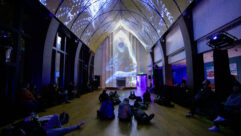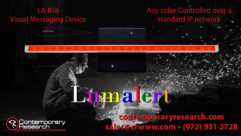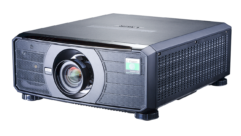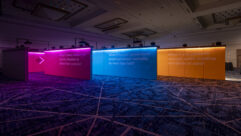Herding Light
By manipulating light waves, photonic crystals improve the efficiency of AV technologies such as LEDs.
Photonic crystals bend and focus light. Made out of a transparent material, such as glass, the crystals are packed with holes that are as small as a light wave. AV manufacturers such as Luminus Devices have begun using photonics for applications such as brighter, more colorful LEDs.
THE TERM “PHOTONIC CRYSTAL” might not ring a bell, but you’ve seen them millions of times, thanks to the fact that nature has been mass producing them for a few millennia. Their unique ability to bend and focus light makes it likely that you’ll start to see their techniques in pro AV products such as LED displays.
“Whenever you see iridescent colors in nature, chances are that you are looking at a photonic crystal,” says Steven Johnson, an assistant professor of applied mathematics at the Massachusetts Institute of Technology (MIT) who’s spent the past few years researching photonics. “Tiny photonic crystals have already been found in everything from peacock feathers to butterfly wings to precious opals.”
To understand how photonic crystals work, it helps to understand what light is and how it behaves. Light essentially is similar to radio waves, except that it sits so far up in the electromagnetic spectrum that it’s visible to the naked eye. The gaps between two adjacent waves is known as the wavelength.
“Different wavelengths correspond to different colors,” Johnson says. “In a uniform material, such as air or glass, light propagates with a simple behavior that has been predictable for over a century.”
Photonic crystals literally throw a curve ball. Made out of a transparent material, such as glass, the crystals are pocked with holes that are as small as a light wave.
“Because of these structures, light behaves much differently than it does in uniform materials and can be made to do strange things,” Johnson says. “For example, the crystal can be designed to have a ‘photonic band gap,’ which is a range of wavelengths where light can’t penetrate the material.”
These barriers herd the light waves in one — and only one — direction, much like insulators around electric wires keep the current from arrowing off wherever it wants. There are plenty of naturally occurring materials that also make light do weird things.
“For example, light bends when it strikes an interface between two materials, such as air and water,” Johnson says. “This is why, when you dip your finger into a glass of water and look from above, the portion of your finger in the water seems to be mismatched with the portion above the water.”
Another well-known distorter is a prism, which leverages the fact that different wavelengths — or colors — bend at different angles. That’s why a prism is able to fan a beam of white light into a rainbow.
“A photonic crystal can be designed to distort or amplify this effect so that light is bent much more than in an ordinary material, or in the opposite direction (‘negative refraction’), or with a much greater separation of wavelengths (a ‘super prism’),” Johnson says.
In theory, photonic crystals have no limitations, such as color, in terms of their ability to manipulate light. In practice, however, their limitations currently center around materials and manufacturing techniques. “Photonic crystals can generally be designed to interact with any light color that you want, just by changing the size of the structure, as long as you have transparent materials for that color,” Johnson says.
Waste not, want not
All of that sounds like an interesting science project, and it is, but photonic crystals also have practical AV applications. One example is light-emitting diodes (LEDs), where conventional technology wastes light by scattering it.
“Most of the light in a conventional LED never escapes from the chip,” says Alexei Erchak, chief technology officer at Woburn, MA-based Luminus Devices, whose PhlatLight technology uses photonics. “Light trying to escape is mostly reflected and reabsorbed, turning into heat.”
Photonic crystals assist by keeping more of the light on track. That guidance has at least two benefits. The first is increased brightness because less light is scattered.
“Photonic crystals improve LED efficiency by forcing light to be extracted from the chip,” Erchak says. “Light literally can’t travel inside the chip because of the intricate pattern of the photonic crystal structure, so it must escape. Often, this can lead to 10X greater brightness than conventional LEDs.”
The second benefit is the ability to crank up the vibrancy of a particular color. “Because a photonic crystal can be made to respond differently to different wavelengths (colors), it can make the LED emit a particular color more brilliantly than others,” Johnson says.
Although commercial AV applications of photonic crystals are rare, early efforts are promising in the sense that the benefits literally are difficult to overlook. For example, Luminus Devices’ PhlatLight technology was used in a Samsung 56-inch, rear-projection TV that won the Best of 2006 award at this year’s Consumer Electronics Show.
More manipulation and manufacturing
LEDs aren’t the only existing technology that can get a boost from photonic crystals. Another is low-power lasers. Although lasers currently are used in AV mainly for pointers, companies such as Novalux and Mitsubishi Electric have recently commercialized projection TVs that use lasers as a light source.
“The applications of photonic crystals are somewhat unlimited,” Erchak says. “Most display applications benefit from the ability to control, manipulate, or mold the flow of light.”
How quickly photonic crystals show up in projection displays or other AV products depends partly on researchers’ ingenuity and imagination. “We still haven’t figured out all of the things that these tiny structures can make possible,” Johnson says.
Although nature has been mass producing photonic crystals for millions of years, humans are still looking for ways to make them in large volumes —and cost-effectively. On the plus side, future applications could leverage existing manufacturing equipment and processes from adjunct industries. “Many existing photonic crystal structures are based on exactly the same microfabrication technology that is used to etch nanometer-scale patterns for computer chips,” Johnson says.
In the case of Luminus Devices, the company sought to improve its market potential by focusing on manufacturability. “Although photonic crystal devices have been reported widely in research journals for the past 10 to 15 years, they haven’t been deployed in large volume in commercial applications due to the manufacturing complexity,” Erchak says. “For example, due to their small nanoscale features, photonic crystals need to be patterned using advanced lithographic techniques. The photonic crystal structure in PhlatLight is unique in that it’s designed specifically for high-volume manufacturing.”
One area of future innovation is creating photonic crystals that use three-dimensional (3D) patterns to get even more control over light.
“3D photonic crystals give you the highest level of control since light traveling in any direction must interact with the photonic crystal,” Erchak says. “Unfortunately, 3D photonic crystals are also the most difficult to manufacture cost-effectively.”
MORE ON WWW.PROAVMAGAZINE.COM
For more information about photonic crystals and technologies that they can impact, check out:
- Steven Johnson and his MIT colleagues have written several books and papers about photonic crystals. For a list and links, visit http://ab-initio.mit.edu/papers.html.
- Luminus Devices’ website at www.luminus.com has more details about its PhlatLight technology on its News page.
- What’s Next: A Better Light – After nearly a half-century of development, lasers are set to move inside TVs, digital signage, and cinema projectors, April 2006
- All About LEDs – Light-emitting diodes have come a long way over the past decade. Here’s why they’re showing up in more pro AV applications, January 2006
But for researchers such as Johnson and Erchak, the additional control over light makes 3D mass-production techniques a brass ring worth reaching for.
“Methods to fabricate such structures have involved stacking a sequence of two-dimensional patterns (in the same way the chip manufacturers are working hard to make 3D integrated circuits), 3D holograms, and self-assembly of microscopic spheres that automatically pack and stick together,” Johnson says.
Luminus Devices also is working on photonic LEDs for use as liquid crystal display (LCD) back-lights. The company is working with Brecksville, OH-based Global Lighting Technologies (GLT) on highly efficient ways to illuminate LCDs from the edge.
“This technology is enabling, for the first time, large-screen LED LCD TVs,” Erchak says. “The photonic crystal in the PhlatLight chipset collimates the emitted light so that it can be efficiently coupled into a light-distribution system, designed by GLT, and uniformly illuminate the LCD panel.”
Tim Kridel is a freelance writer and analyst who covers telecom and technology. He’s based in Kansas City and can be reached at [email protected].










